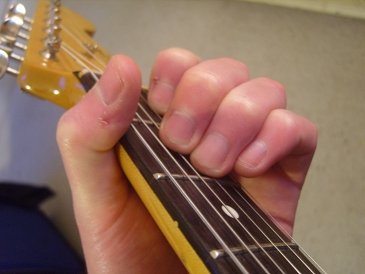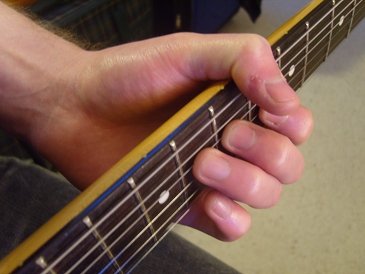Home › Q&A
Fingers not strong enough after years of playing
Question by David
(Lincolnshire )
Hey, I've been playing guitar for over 5 years yet my thumb/fingers feels like it's had a 2 hour work out after playing the guitar for only 10-20 mins.
I've tried the finger strength exercises but my thumb which I use to hold my guitar behind the neck is my weak link, it cracks a lot when I move it from only 5 mins of playing. Any advice on how much pressure/how to hold your guitar properly? Because I'm certain this is the problem.
Unfortunately I don't know anyone around my area that plays guitar that can help.
Suggestions
David, you mentioned you've tried finger strength exercises, but do you use any finger stretching exercises before playing?Stretching and strengthening are two separate types of exercise, and warming up/stretching should come before everything else.
What I usually recommend to students with joint pain that only occurs when playing guitar is to limit your playing to the period of time when there is no pain or other problems.
Even if that's only 15 minutes, it's crucial you don't exert yourself to the point where a minor problem becomes an injury. It's also not a productive use of your time to try and practice with unnecessary obstructions, such as pain.
So, as soon as you start to feel any joint pain (not aching - that's just your muscles being worked!) put down the guitar and rest for 15 minutes, perhaps have another stretch, or however long it takes for the pain/problem to subside.
After a week or so of this routine, you might find you can add on a couple of minutes, or even 5-10 extra minutes before the problem arises.
If, however, after 2 weeks of daily practice using the 15 minutes on / 15 minutes break routine there is no improvement, it's time to look at your hand positioning.
The reason I would wait until this point to check your hand positioning is because you've been playing for over 5 years, so you've developed your muscle memory to quite an advanced level and changing hand positioning at this stage will not be easy.
First, I know it's going right back to basics, and may seem a little patronising now, but go through the lesson on how to hold a guitar.
If you can already check all the boxes from that lesson (i.e. you're already doing everything as specified), then try the following...
Many guitarists, especially those with larger hands, find it more comfortable to raise their wrist and bring their thumb up and over the edge of the guitar neck as follows:


So the palm of my fret hand is almost cupping the back of the neck. There are degrees to which you can do this, so you need to experiment with this to find the position that works for you.
It might look a bit weird if you're used to having your thumb positioned more on the back of the neck, but some guitarists find the above position, although not ideal, relieves a lot of tension in both their wrist and thumb joint.
Again, you might struggle with this if you have smaller hands.
The only other problem with this position, and the reason I don't recommend it for absolute beginners, is that when you play certain chords (such as barre chords), your thumb will need to quickly move back down to the centre of the neck to support the shape.
However, this is how I play it, and eventually your thumb just moves to the appropriate position without thinking about it. It's not the most efficient way of holding the guitar, but it's better than enduring joint pain/problems and being put off guitar altogether.
Be prepared to "re-learn" some chord fingerings and changes if you adopt this new positioning.
Another way you can help improve your finger endurance is to make sure you drink plenty of water to make sure you're properly hydrated and eat plenty of energy rich, healthy foods (I don't want to sound too much like a doctor here, but it does help).
A banana goes a long way.
So, in summary...
1) Make sure you spend 5-10 minutes stretching before playing.
2) Practice in 15 minute bursts and rest for 15 minutes in between.
3) If no improvement after two weeks, try changing your thumb position like in the photos above.
4) If still no improvement, let me know using the comments link below and we can go from there!
Share Your Comments
|
||
|
||
|
||
|
||
|
||
|
||